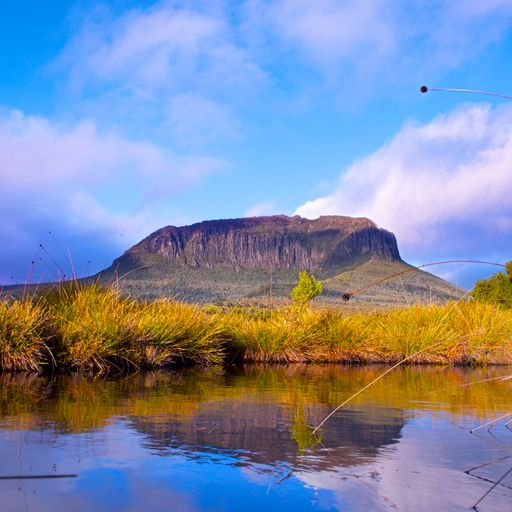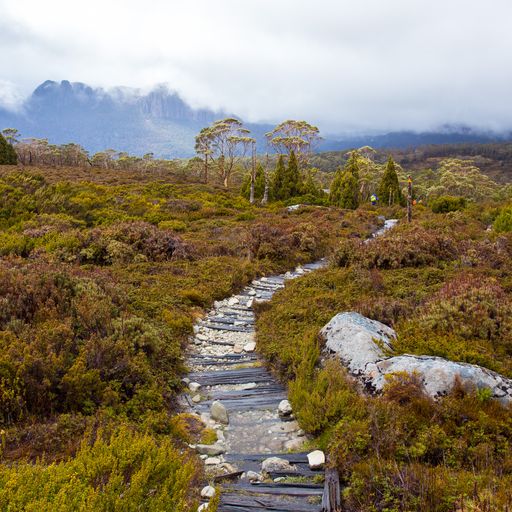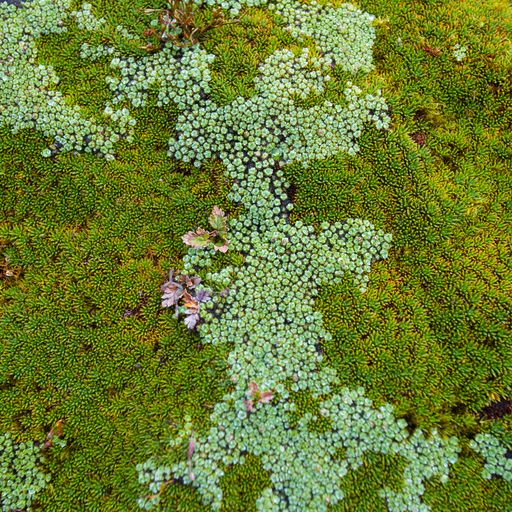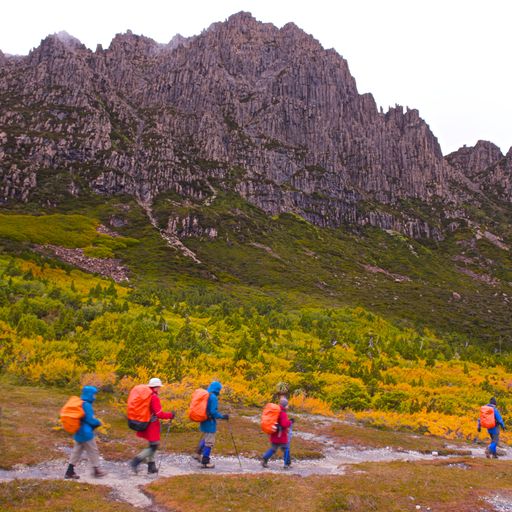Australian Geographic Expedition – Cradle Mountain Huts Autumn Botany Walk, Tasmania

| Dates | 22 – 27 April 2024 |
| Activity Level | Medium fitness required. 65km trail walking over 6 days. See more info below. |
| Duration | 6 days, 5 nights |
| Price | From $4795 per person (twin share accommodation) |
| Group Size | Maximum 12 |
| Featuring Regions | Cradle Mountain, Cradle Valley, Lake St Clair, The Overland Track, Tasmania |
Activities Summary
Duration: 6 days Grade: Introductory to moderate
Activities: Walking
Accommodation style: Huts
What to Expect
Tasmania’s Overland Track is famous the world over and this signature trip is the way to experience it in classic style. Across six days, our most popular Overland experience completes the full journey from World Heritage-listed Cradle Mountain to Lake St Clair.
The fully guided walk begins at Waldheim in Cradle Valley and journeys some 65km to Lake St Clair, Australia’s deepest natural lake. This trip does not include multiple side trips, but there is the opportunity on Day 4 to club to the summit of Mount Ossa.
Autumn puts on an incredible show on the Overland! The contrast in colours during the turning of the deciduous beech, Nothofagus gunnii, is set against a backdrop of dramatic dolerite mountains, and is complemented by the vast collection of ancient Gondwana species.
The cooler temperatures bring with them the possibility of waking up to a dusting of snow. Witnessing the plants and fungi in a wet and cooler environment also means everything looks it’s happiest.
Introducing Danah Leary
Tasmanian Danah Leary grew up in Tasmania with prehistoric rainforests and majestic dolerite mountains as her home.
She drew early inspiration from the fieldwork of her parents. Later, it would be extensive overseas travel that fuelled her passion for places of cultural and natural significance. Danah studied Fine Arts at the University of Tasmania before qualifying as a horticulturalist and completing her studies in conservation. She currently leads her dream life: guiding for the Tasmanian Walking Company on the Overland Track, contract work for North Barker Ecosystem Services, and assisting the start-up of a seed bank in Central Victoria with Cassinia Environmental as a Native Seed Coordinator.
From a young age Danah drew botanical art, deriving endless inspiration from the endemic alpine plants, fungi and fish seen along the way. Her passion for botany grew with each trip she guided on The Overland Track. She holds a special interest in alpine flora and the symbiotic relationships that have developed over many years between certain species. She hopes to show how incredibly special and important these species are while adventuring through one of her favourite places in the world.
Detailed Itinerary

Day 1: Waldheim to Barn Bluff Hut
Approximate 7-hour walk
On the summit of Cradle Mountain in 1910, Austrian-born Gustav Weindorfer proclaimed, “This must be a national park for the people for all time.” It’s fitting our journey begins at Waldheim in Cradle Valley, where Weindorfer’s story is told. We set off on the track, venturing through ancient temperate rainforest, passing the dramatic glacially carved Crater Lake.
We climb the steepest section of the whole Overland Track today, fuelled by a hearty lunch. Reaching Marion’s Lookout (1250m) takes about an hour, with steps leading through steeper sections. The reward, providing weather conditions allow, is staggering views of Cradle Mountain and Dove Lake. Every uphill step is worth it.
We continue around the base of Cradle Mountain along the edge of a spectacular glacial cirque before dropping into Waterfall Valley. Our private hut awaits, beneath towering Barn Bluff, having completed the steepest part of your journey (excluding side trips). It’s a welcome retreat after several hours of walking over exposed alpine plateau, where some days the wind howls – a reminder of nature’s power.
Botany highlights:
- Botanist Kate and Gustave Weindorfer’s story
- Acknowledgement of Country in front of buttongrass plains
- Witness the turning of the ancient deciduous beech, Nothofagus gunnii
- Crater Lake in autumn
- Richea, Leptospermum, Sprengelia
- History of botany
- Overland Gin.

Day 2: Barn Bluff Hut to Pine Forest Moor Hut
Approximate 6-hour walk
Today we’ll be walking across plains where glaciers once rested, slowly moving and scouring out shallow tarns. Although an undulating trek with a few sections of exposed moorland, there are no significant climbs today.
We take our time venturing across vast buttongrass plains where ancient pencil pines fringe alpine tarns. Rising from the moors, the peaks of Cradle Mountain and Barn Bluff are behind us. Look ahead and the stately Mt Pelion West comes into view.
Those looking for an additional challenge today can take a side trip to Lake Will. Hugged by pencil pines and with its narrow quartzite sand rim, it is striking. Keep an eye out for gravel mounds along the way, remnants of Joseph Will’s coal-mining efforts in the 1890s.
This evening, at Pine Forest Moor Hut, enjoy our outdoor dining setting with views out to Mt Oakleigh in fine weather.
Botany highlights (and more):
- Lake Will: Cretaceous quillworts (family Isoetaceae)
- Lake Windermere: Dwarf leatherwood Eucryphia Mililani
- Mushrooms and moss in the Enchanted Forest
- Carboniferous and Mesozoic coal
- Introduction to the geology and history of the mountains
- Lemon myrtle scones.

Day 3: Pine Forest Moor Hut to Pelion Hut
Approximate 5-hour walk
This morning we venture through gorgeous myrtle-beech rainforest as we descend around the base of Mt Pelion West, down to Forth River before it plunges into Lemonthyme Valley. We’ll take a break at Frog Flats beside Forth River, which happens to be the Overland Track’s lowest point.
From here, it’s a gentle ascent back out of the valley. We leave thick eucalypt forest behind as the trees part to reveal Pelion Plains. Uninterrupted views of Mt Oakleigh’s dolerite spires now come into play.
The Pelion Plains area offers a host of side trips, hugged by mountainous terrain. There are excellent swimming holes, peaceful nooks to rest and abandoned copper mines to explore. Come nightfall, we’ll be nestled in dry sclerophyll forest at Pelion Hut.
Botany highlights:
- Walk with some of the tallest angiosperms (flowering plants) Eucalyptus regnans and E. delicateness
- Sit with bonsai Antarctic myrtles, Nothofagus cunninghamii, while enjoying sassafras tea, Atherosperma moschatum
- Enjoy a fresh lunch on a Permian fossils beach
- Experience the dolerite spires of Mt Oakleigh (weather permitting) and cider gum, Eucalyptus Gunnii forest.

Day 4: Pelion Hut to Kia Ora Hut
Approximate 4–9 hour walk (optional 5-hour side trip to Mt Ossa)
Today begins with a climb of almost 300m to Pelion Gap through beautiful rainforest. Pelion Gap is a plateau stretching between Mt Pelion East and Mt Ossa, affording fantastic views to the south as well as back to the north.
There’s plenty of time for side trips from Pelion Gap, including the option to summit Mt Ossa. At 1617m, it is Tasmania’s highest peak. There are other less-challenging climbs, including Mt Doris.
From Pelion Gap, it’s a further two hours of gentle downhill to the hut. Today, choose to keep things relaxed or challenge yourself to stand atop the island’s highest point. Once we arrive at Kia Ora Hut, enjoy a Tasmanian drop with spectacular views out to Cathedral Mountain.
Botany highlights:
- Witness species evolving (Richea x curtisiae and Athrotaxis x laxifolia)
- Masting events and mycelium
- 2000-year-old King Billy pines, Athrotaxis selaginoides
- The Japanese Garden and Mt Ossa (weather permitting)
- Cushion plants alongside endemic, ancient bonsaied pines
- Evolution of Tasmanian snow gums, Eucalyptus coccifera
- Mushroom risotto with native pepperberries.

Day 5: Kia Ora Hut to Windy Ridge Hut
Approximate 4-hour walk
Day five is about icy-flowing waterfalls. We depart Kia Ora Hut and walk about an hour to Du Cane, where a 1910-built hut remains from the long-gone days of animal trapping. Du Cane Hut is a fine spot to rest, surrounded by native gardens and with views of the spectacular Du Cane Range.
From here, we wander through some of the oldest forest in the national park – its King Billy pines as much as 2000 years old. Now, we’re above the Mersey River, which descends deeply northward towards Bass Strait, spilling down cliff faces.
There are three major sets of waterfalls in the area. We aim to visit one or more of these, choosing the best to have lunch beside, depending on the conditions. During the afternoon, we make our way over Du Cane Gap, then descend beside the spectacular Falling Mountain to Windy Ridge Hut. Tonight is a celebratory one, our last evening on the track.
Botany highlights (and more):
- Walk through the hut built from a single King Billy pine
- Silent walk through old-growth forests (look up to see native tree creepers)
- Encounter the incredibly special Nursery log
- View incredible waterfalls, Dracophyllum milliganii and endemic Galaxias fish
- Walk home through dry sclerophyll forests, turning into vibrant alpine yellow gums forests, Eucalyptus subcrenulata.

Day 6: Windy Ridge Hut to Lake St Clair
Approximate 3-hour walk
Our destination today is Australia’s deepest natural lake – Lake St Clair – shaped by glaciations over two million years. Birdsong helps us along this final day as we walk mainly through flowering dry sclerophyll forests.
We arrive at Narcissus at the northern end of Lake St Clair in time for lunch, before boarding the Idaclair cruise boat for a spectacular 17km cruise back to Cynthia Bay. There’s typically around half an hour to look around the Visitor Centre here.
The return trip to Entally Lodge is through the trout-fishing mecca of the highland lakes, descending the rugged Western Tiers. We’ll cross the broad plains of the Northern Midlands, passing through the rural townships of Cressy and Longford.
Botany highlights:
- Glaciers and their effect in the parks
- A final walk-through of beautiful sections of old-growth rainforest and dry sclerophyll eucalyptus forests
- Keep an eye out for pink robins, grey fantails and flocks of endemic green rosellas
- An array of native and endemic plants, many of which date back to Gondwana times.
What’s included
- Return transfers between Launceston and the walk base
- Accommodation each evening in one of our five private huts – twin share
- All meals and non-alcoholic beverages, plus a limited selection of Tasmanian wines
- National Park and Overland Track passes
- Boat transfer across Lake St Clair (on Day 6 of the six day walk only)
- Use of a backpack and Gore-tex jacket for the duration of the walk
- Sleeping bags, pillows and a comfortable mattress at each hut
- Sleeping sheet and pillowcase to carry with you
- Two qualified guides for the duration of the walk.
What’s not included
- Travel insurance
- Flights to and from departure points
- Items not mentioned in the above list or the detailed itinerary.
The track, the weather and preparation required
At any time of the year, you can experience extreme conditions on the Overland Track. Freezing temperatures, wind, rain, sleet, and snow can occur. The Track itself has earned a reputation as one of Australia’s great hiking challenges. Over six days, you will carry a pack, climb to alpine passes and if weather permits, to the top of Mt Ossa. The trail is uneven, rocky, slippery, wet, muddy, has many exposed tree roots and is not well-maintained. It is wild, remote and you cannot be rescued easily. Preparing well for your walk helps you complete the walk and makes it much more enjoyable.
The weather adds another challenge and persistent rain and even snow are possible in summer. Wool socks, merino thermal layers, quality wet weather gear and hiking poles all assist. Please ensure you are fit and able and follow the advice on what to pack in our gear list. If you follow the training plan, you will find the walk more enjoyable. If you have any questions, please contact our reservations team. Below are some images of the track in snow and after rain. Enjoy the comfort of warm and dry huts each evening! Please prepare and pack well and follow the advice in our trip notes’ training plan.
Exclusive accommodation
True shelter, something that gives protection and refuge, simple and sustainable, clean and comfortable.
Our groups have the exclusive use of the only private hut accommodation along the Overland Track. Each hut has been discretely located off the main trail and offers a hot shower, drying room and twin share accommodation.
Our private huts
Operating and owning the only private hut accommodation along the Overland Track is a great privilege, and we take our responsibility toward the National Park & the natural environment very seriously. Operating in such a delicate environment, Cradle Mountain Huts places a great deal of importance on minimal impact track and hut practices and the huts are designed to be ecologically sustainable. Each hut is architecturally designed to maximise cross-flow ventilation and operate with maximum efficiency with renewable energy. Our private Cradle Mountain Huts are maintained by us to ensure your comfort.
There will be afternoon tea, as well as some time to relax and enjoy your surroundings before dinner is served. In the evening, you are free to relax or take an early night and feel refreshed and revived in the morning.
There are games and a number of books in each hut, which can be enjoyed in the lounge area or, in warm weather, out on the deck or helipad.
The remote location of the huts demands that they are autonomous in terms of servicing. Rain water is chanelled off the roofs into tanks and the huts incorporate self-composting, water-free batching toilets. We provide phosphorous-free soap for our guests, and all waste water is separated through grease traps and sand filters. The residue is regularly removed from each site, along with all other rubbish. Gas and solar are the only sources of power, used for lighting, heating and cooking.
Provisioning of these huts is a unique procedure, once again due to their remote location. Only twice each season, supplies of food, wine and gas cylinders are flown in by helicopter over a two-day period, while all garbage and waste matter is flown out. Nothing is left within the National Park.
Your safety and well‐being continues to be our utmost priority as you plan and then depart on your active holiday. Since the outbreak of COVID‐19 we have evolved our operating protocol to build in additional measures on our existing safety and risk mitigation strategies.
We’ve seen the incredible success of the vaccination program and new found freedoms a high level of vaccination brings. On that basis, it is our requirement that you are fully vaccinated in order to join this trip. For more information please contact us at [email protected]. Before you travel make sure you understand and follow all airline and destination requirements related to travel, mask wearing, testing, or quarantine, which may differ from your own country’s requirements. If you do not follow your destination or transit countries’ requirements, you may be denied entry and required to return to your home country.
Keeping up to date with individual countries requirements and restrictions can be difficult as policies are changing daily. The following website is a useful resource https://www.iatatravelcentre.com/ world.php. Please contact us if you have any questions and we will do our best to answer in relation to current conditions.
Book Now